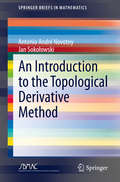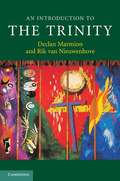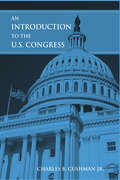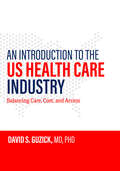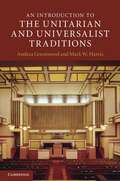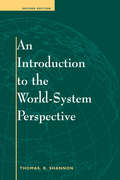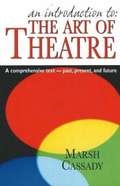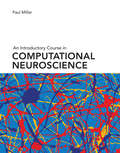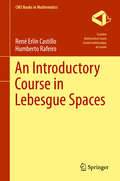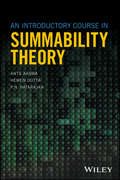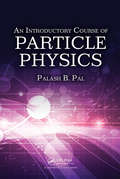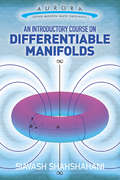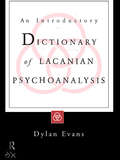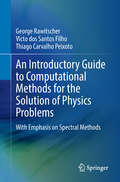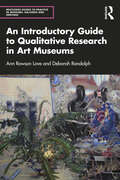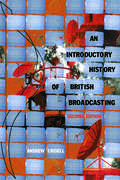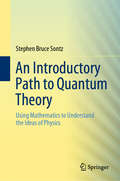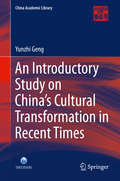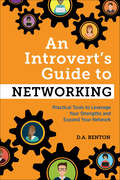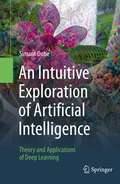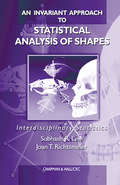- Table View
- List View
An Introduction to the Topological Derivative Method (SpringerBriefs in Mathematics)
by Antonio André Novotny Jan SokołowskiThis book presents the topological derivative method through selected examples, using a direct approach based on calculus of variations combined with compound asymptotic analysis. This new concept in shape optimization has applications in many different fields such as topology optimization, inverse problems, imaging processing, multi-scale material design and mechanical modeling including damage and fracture evolution phenomena. In particular, the topological derivative is used here in numerical methods of shape optimization, with applications in the context of compliance structural topology optimization and topology design of compliant mechanisms. Some exercises are offered at the end of each chapter, helping the reader to better understand the involved concepts.
An Introduction to the Trinity
by Rik Van Nieuwenhove Declan MarmionOver the last decade there has been a resurgence of writing on the Trinity, indicating a renewal of ideas and debate concerning this key element of Christian theology. This introduction challenges the standard account of a decline and revival in Trinitarian theology, taking into account recent, alternative readings of the theological tradition by Lewis Ayres and Michel Barnes amongst other scholars. By clearly analysing the scope of these new approaches, the authors establish the importance of a considered understanding of the Trinity, resisting the notion of separating faith and reason and identifying theology's link to spirituality. Their account also eschews the easy stereotypes of Western Christianity's supposedly more Unitarian approach as opposed to the more Trinitarian view of the East. Offering an overview of the main people and themes in Trinitarian theology past and present, this book thus provides an accessible, comprehensive guide for students and scholars alike.
An Introduction to the U.S. Congress
by Charles B. CushmanWhat does Congress do? How does it do it? Why is it such a complicated institution? This concise primer offers students and general readers a brief and systematic introduction to Congress and the role it plays in the US political system. Drawing on his experience as a former Congressional staff member, the author explores the different political natures of the House and Senate, examines Congress's interaction with other branches of the Federal government, and looks ahead to the domestic and foreign challenges that are likely to drive the Congressional agenda for decades to come. The book provides revealing insights into the sometimes-contradictory Congressional responsibilities of representation and lawmaking; oversight and appropriation; and managing and organizing the government. It includes a case study (on the formation of the Department of Homeland Security) that sheds light on Congress's often-complicated procedures. The book also includes boxed features on Congressional action - highlighting such topics as file sharing and student loans - that show students how Congress's work affects their lives. Chapter-ending lists of web resources add to the book's usefulness.
An Introduction to the US Health Care Industry: Balancing Care, Cost, and Access
by David S. GuzickWhy does US health care have such high costs and poor outcomes? Dr. David S. Guzick offers this critique of the American health care industry and argues that it could work more effectively by rebalancing care, cost, and access.For decades, the United States has been faced with a puzzling problem: Despite spending much more money per capita on health care than any other developed nation, its population suffers from notoriously poorer health. In comparison with 10 other high-income nations, in fact, the US has the lowest life expectancy at birth, the highest rates of infant and neonatal mortality, and the most inequitable access to physicians when adjusted for need. In An Introduction to the US Health Care Industry, Dr. David S. Guzick takes an in-depth look at this troubling issue. Bringing to bear his unique background as a physician, economist, former University of Rochester medical school dean, and former president of the University of Florida Health System, Dr. Guzick shows that what we commonly refer to as the US health care "system" is actually an industry forged by a unique collection of self-interested and disjointed stakeholders. He argues that the assumptions underlying well-functioning markets do not align with health care. The resulting market imperfections, combined with entrenched industry stakeholders, have led to a significant imbalance of care, cost, and access.Using a nontechnical framework, Dr. Guzick introduces readers to the economic principles behind the function—and dysfunction—of our health care industry. He shows how the market-based approach could be expected to remedy these problems while detailing the realities of imperfections, regulations, and wealth inequality on those functions. He also analyzes how this industry developed, presenting the conceptual underpinnings of the health care industry while detailing its history and tracing the creation and entrenchment of the current federation of key stakeholders—government, insurance companies, hospitals, doctors, employers, and drug and device manufacturers. In the final section of the book, Dr. Guzick looks to the future, describing the prevention, innovation, and alternative financing models that could help to rebalance the priorities of care, cost, and access that Americans need.An online supplement on COVID-19 is available, as is a discussion guide for instructors. To access this supplemental material, please visit www.jhupbooks.press.jhu.edu.
An Introduction to the Unitarian and Universalist Traditions
by Andrea Greenwood Mark W. HarrisHow is a free faith expressed, organised and governed? How are diverse spiritualities and theologies made compatible? What might a religion based in reason and democracy offer today's world? This book will help the reader to understand the contemporary liberal religion of Unitarian Universalism in a historical and global context. Andrea Greenwood and Mark W. Harris challenge the view that the Unitarianism of New England is indigenous and the point from which the religion spread. Relationships between Polish radicals and the English Dissenters existed and the English radicals profoundly influenced the Unitarianism of the nascent United States. Greenwood and Harris also explore the US identity as Unitarian Universalist since a 1961 merger and its current relationship to international congregations, particularly in the context of twentieth-century expansion into Asia.
An Introduction to: A Comprehensive Text-Past, Present, and Future
by Marsh CassadyThis semester-long, introductory theatre textbook is highly readable and created specifically to instill a strong interest in theatre.
An Introductory Course in Computational Neuroscience (Computational Neuroscience Series)
by Paul MillerA textbook for students with limited background in mathematics and computer coding, emphasizing computer tutorials that guide readers in producing models of neural behavior. This introductory text teaches students to understand, simulate, and analyze the complex behaviors of individual neurons and brain circuits. It is built around computer tutorials that guide students in producing models of neural behavior, with the associated Matlab code freely available online. From these models students learn how individual neurons function and how, when connected, neurons cooperate in a circuit. The book demonstrates through simulated models how oscillations, multistability, post-stimulus rebounds, and chaos can arise within either single neurons or circuits, and it explores their roles in the brain. The book first presents essential background in neuroscience, physics, mathematics, and Matlab, with explanations illustrated by many example problems. Subsequent chapters cover the neuron and spike production; single spike trains and the underlying cognitive processes; conductance-based models; the simulation of synaptic connections; firing-rate models of large-scale circuit operation; dynamical systems and their components; synaptic plasticity; and techniques for analysis of neuron population datasets, including principal components analysis, hidden Markov modeling, and Bayesian decoding. Accessible to undergraduates in life sciences with limited background in mathematics and computer coding, the book can be used in a “flipped” or “inverted” teaching approach, with class time devoted to hands-on work on the computer tutorials. It can also be a resource for graduate students in the life sciences who wish to gain computing skills and a deeper knowledge of neural function and neural circuits.
An Introductory Course in Functional Analysis (Universitext)
by Adam Bowers Nigel J. KaltonBased on a graduate course by the celebrated analyst Nigel Kalton, this well-balanced introduction to functional analysis makes clear not only how, but why, the field developed. All major topics belonging to a first course in functional analysis are covered. However, unlike traditional introductions to the subject, Banach spaces are emphasized over Hilbert spaces, and many details are presented in a novel manner, such as the proof of the Hahn-Banach theorem based on an inf-convolution technique, the proof of Schauder's theorem, and the proof of the Milman-Pettis theorem. With the inclusion of many illustrative examples and exercises, An Introductory Course in Functional Analysis equips the reader to apply the theory and to master its subtleties. It is therefore well-suited as a textbook for a one- or two-semester introductory course in functional analysis or as a companion for independent study.
An Introductory Course in Lebesgue Spaces (CMS Books in Mathematics)
by Rene Erlin Castillo Humberto RafeiroThis book is devoted exclusively to Lebesgue spaces and their direct derived spaces. Unique in its sole dedication, this book explores Lebesgue spaces, distribution functions and nonincreasing rearrangement. Moreover, it also deals with weak, Lorentz and the more recent variable exponent and grand Lebesgue spaces with considerable detail to the proofs. The book also touches on basic harmonic analysis in the aforementioned spaces. An appendix is given at the end of the book giving it a self-contained character. This work is ideal for teachers, graduate students and researchers.
An Introductory Course in Summability Theory
by P. N. Natarajan Hemen Dutta Ants AasmaAn introductory course in summability theory for students, researchers, physicists, and engineers In creating this book, the authors’ intent was to provide graduate students, researchers, physicists, and engineers with a reasonable introduction to summability theory. Over the course of nine chapters, the authors cover all of the fundamental concepts and equations informing summability theory and its applications, as well as some of its lesser known aspects. Following a brief introduction to the history of summability theory, general matrix methods are introduced, and the Silverman-Toeplitz theorem on regular matrices is discussed. A variety of special summability methods, including the Nörlund method, the Weighted Mean method, the Abel method, and the (C, 1) - method are next examined. An entire chapter is devoted to a discussion of some elementary Tauberian theorems involving certain summability methods. Following this are chapters devoted to matrix transforms of summability and absolute summability domains of reversible and normal methods; the notion of a perfect matrix method; matrix transforms of summability and absolute summability domains of the Cesàro and Riesz methods; convergence and the boundedness of sequences with speed; and convergence, boundedness, and summability with speed. • Discusses results on matrix transforms of several matrix methods • The only English-language textbook describing the notions of convergence, boundedness, and summability with speed, as well as their applications in approximation theory • Compares the approximation orders of Fourier expansions in Banach spaces by different matrix methods • Matrix transforms of summability domains of regular perfect matrix methods are examined • Each chapter contains several solved examples and end-of-chapter exercises, including hints for solutions An Introductory Course in Summability Theory is the ideal first text in summability theory for graduate students, especially those having a good grasp of real and complex analysis. It is also a valuable reference for mathematics researchers and for physicists and engineers who work with Fourier series, Fourier transforms, or analytic continuation. ANTS AASMA, PhD, is Associate Professor of Mathematical Economics in the Department of Economics and Finance at Tallinn University of Technology, Estonia. HEMEN DUTTA, PhD, is Senior Assistant Professor of Mathematics at Gauhati University, India. P.N. NATARAJAN, PhD, is Formerly Professor and Head of the Department of Mathematics, Ramakrishna Mission Vivekananda College, Chennai, Tamilnadu, India.
An Introductory Course of Particle Physics
by Palash B. PalFor graduate students unfamiliar with particle physics, An Introductory Course of Particle Physics teaches the basic techniques and fundamental theories related to the subject. It gives students the competence to work out various properties of fundamental particles, such as scattering cross-section and lifetime. The book also gives a lucid summary
An Introductory Course on Differentiable Manifolds
by Siavash ShahshahaniBased on author Siavash Shahshahani's extensive teaching experience, this volume presents a thorough, rigorous course on the theory of differentiable manifolds. Geared toward advanced undergraduates and graduate students in mathematics, the treatment's prerequisites include a strong background in undergraduate mathematics, including multivariable calculus, linear algebra, elementary abstract algebra, and point set topology. More than 200 exercises offer students ample opportunity to gauge their skills and gain additional insights.The four-part treatment begins with a single chapter devoted to the tensor algebra of linear spaces and their mappings. Part II brings in neighboring points to explore integrating vector fields, Lie bracket, exterior derivative, and Lie derivative. Part III, involving manifolds and vector bundles, develops the main body of the course. The final chapter provides a glimpse into geometric structures by introducing connections on the tangent bundle as a tool to implant the second derivative and the derivative of vector fields on the base manifold. Relevant historical and philosophical asides enhance the mathematical text, and helpful Appendixes offer supplementary material.
An Introductory Dictionary of Lacanian Psychoanalysis
by Dylan EvansJacques Lacan's thinking revolutionised the theory and practice of psychoanalysis and had a major impact in fields as diverse as film studies, literary criticism, feminist theory and philosophy. Yet his writings are notorious for their complexity and idiosyncratic style. Emphasising the clinical basis of Lacan's work, An Introductory Dictionary of Lacanian Psychoanalysis is an ideal companion to his ideas for readers in every discipline where his influence is felt. The Dictionary features:* over 200 entries, explaining Lacan's own terminology and his use of common psychoanalytic expressions* details of the historical and institutional context of Lacan's work* reference to the origins of major concepts in the work of Freud, Saussure, Hegel and other key thinkers* a chronology of Lacan's life and works.
An Introductory Guide to Computational Methods for the Solution of Physics Problems (Lecture Notes in Physics #955)
by George Rawitscher Victo dos Santos Filho Thiago Carvalho PeixotoThis monograph presents fundamental aspects of modern spectral and other computational methods, which are not generally taught in traditional courses. It emphasizes concepts as errors, convergence, stability, order and efficiency applied to the solution of physical problems. The spectral methods consist in expanding the function to be calculated into a set of appropriate basis functions (generally orthogonal polynomials) and the respective expansion coefficients are obtained via collocation equations. The main advantage of these methods is that they simultaneously take into account all available information, rather only the information available at a limited number of mesh points. They require more complicated matrix equations than those obtained in finite difference methods. However, the elegance, speed, and accuracy of the spectral methods more than compensates for any such drawbacks. During the course of the monograph, the authors examine the usually rapid convergence of the spectral expansions and the improved accuracy that results when nonequispaced support points are used, in contrast to the equispaced points used in finite difference methods. In particular, they demonstrate the enhanced accuracy obtained in the solution of integral equations.The monograph includes an informative introduction to old and new computational methods with numerous practical examples, while at the same time pointing out the errors that each of the available algorithms introduces into the specific solution. It is a valuable resource for undergraduate students as an introduction to the field and for graduate students wishing to compare the available computational methods. In addition, the work develops the criteria required for students to select the most suitable method to solve the particular scientific problem that they are confronting.
An Introductory Guide to Qualitative Research in Art Museums (Routledge Guides to Practice in Museums, Galleries and Heritage)
by Ann Rowson Love Deborah RandolphAn Introductory Guide to Qualitative Research in Art Museums is a practice-based guide that is designed to introduce qualitative research to established and upcoming museum professionals and increase their confidence to conduct this type of research. Highlighting the work of researchers who are studying museums around the world, the book begins by explaining why there is a need for qualitative research in museums. Rowson Love and Randolph then go on to provide guidance, including theories and frameworks, on how to envision a qualitative research project that facilitates meaningful interpretation of visitor experiences. Chapters in the methodology section begin with descriptions of featured qualitative methodologies and will assist readers as they determine which are most appropriate for their projects and as they advocate for their research. The final section will prepare readers still further by demonstrating data analysis and reporting using the examples in the book. An Introductory Guide to Qualitative Research in Art Museums will help museum professionals and students engaged in the study of museums expand their repertoire to include qualitative methodologies and explain the methods needed to conduct, analyze, and report their qualitative research. It will be particularly useful to those with an interest in museum education, visitor studies and audience research, exhibition development, leadership, and management.
An Introductory History of British Broadcasting
by Andrew CrisellAn Introductory History of British Broadcasting is a concise and accessible history of British radio and television. It begins with the birth of radio at the beginning of the twentieth century and discusses key moments in media history, from the first wireless broadcast in 1920 through to recent developments in digital broadcasting and the internet.Distinguishing broadcasting from other kinds of mass media, and evaluating the way in which audiences have experienced the medium, Andrew Crisell considers the nature and evolution of broadcasting, the growth of broadcasting institutions and the relation of broadcasting to a wider political and social context. This fully updated and expanded second edition includes:*the latest developments in digital broadcasting and the internet*broadcasting in a multimedia era and its prospects for the future*the concept of public service broadcasting and its changing role in an era of interactivity, multiple channels and pay per view*an evaluation of recent political pressures on the BBC and ITV duopoly*a timeline of key broadcasting events and annotated advice on further reading.
An Introductory History of British Broadcasting
by Andrew CrisellAn Introductory History of British Broadcasting is a concise and accessible history of British radio and television. It begins with the birth of radio at the beginning of the twentieth century and discusses key moments in media history, from the first wireless broadcast in 1920 through to recent developments in digital broadcasting and the internet.Distinguishing broadcasting from other kinds of mass media, and evaluating the way in which audiences have experienced the medium, Andrew Crisell considers the nature and evolution of broadcasting, the growth of broadcasting institutions and the relation of broadcasting to a wider political and social context. This fully updated and expanded second edition includes:*the latest developments in digital broadcasting and the internet*broadcasting in a multimedia era and its prospects for the future*the concept of public service broadcasting and its changing role in an era of interactivity, multiple channels and pay per view*an evaluation of recent political pressures on the BBC and ITV duopoly*a timeline of key broadcasting events and annotated advice on further reading.
An Introductory Path to Quantum Theory: Using Mathematics to Understand the Ideas of Physics
by Stephen Bruce SontzSince the 17th century, physical theories have been expressed in the language of mathematical equations. This introduction to quantum theory uses that language to enable the reader to comprehend the notoriously non-intuitive ideas of quantum physics. The mathematical knowledge needed for using this book comes from standard undergraduate mathematics courses and is described in detail in the section Prerequisites. This text is especially aimed at advanced undergraduate and graduate students of mathematics, computer science, engineering and chemistry among other disciplines, provided they have the math background even though lacking preparation in physics. In fact, no previous formal study of physics is assumed.
An Introductory Study on China's Cultural Transformation in Recent Times (China Academic Library)
by Yunzhi GengThis book examines in detail the basic trajectory of the cultural transformation and brings to light the extrinsic conditions and intrinsic mechanisms involved. It focuses on the period from after the Opium Wars to the New Culture Movement, as the New Culture Movement can be considered a pivotal phase in the cultural transformation of modern-day China. The New Culture Movement was a revolutionary eruption triggered by the accumulation of all the new qualitative cultural factors since the Opium Wars. Superficially, the movement's goal seemed to be to overthrow the traditional culture. But in essence its true objective was to conduct an overall "screening" of that culture. The book elaborates a broad variety of points in this context, including: the ideological and cultural evolution following the Opium Wars; the pressing challenges faced by "Zhong Ti"; the initial shaping of social, public and cultural spaces and major trends in ideological and cultural transformation at the end of the Qing Dynasty; the political disarray and conflicts between the new and old ideology in the first years of the Republic; the rise of the New Culture Movement; and the role of conservatism in the transition to a modern culture.
An Introvert's Guide to Networking: Practical Tools to Leverage Your Strengths and Expand Your Network
by D A BentonEncouraging and practical advice to help introverts improve their networking skillsProfessional networking can seem overwhelming, especially if you're introverted in social situations. An Introvert's Guide to Networking is here to make it easier, with everyday advice that helps you leverage your natural strengths like listening, observation, and careful thought, to create connections in ways that feel comfortable and genuine for you.An Introvert's Guide to Networking offers:Helpful, hands-on guidance—Learn networking tips like how to enter (and exit) conversations gracefully, optimize your social media presence, be aware of your body language, and more.Advice for everyone—These inclusive techniques are helpful for people of all career stages, industries, and social skill levels—even extroverts might learn a thing or two.Real examples—Read quotes and anecdotes from introverts who've used their authentic personalities to make successful professional relationships.Start networking more productively today with a book that makes it easier for introverts.
An Intuitive Exploration of Artificial Intelligence: Theory and Applications of Deep Learning
by Simant DubeThis book develops a conceptual understanding of Artificial Intelligence (AI), Deep Learning and Machine Learning in the truest sense of the word. It is an earnest endeavor to unravel what is happening at the algorithmic level, to grasp how applications are being built and to show the long adventurous road in the future.An Intuitive Exploration of Artificial Intelligence offers insightful details on how AI works and solves problems in computer vision, natural language understanding, speech understanding, reinforcement learning and synthesis of new content. From the classic problem of recognizing cats and dogs, to building autonomous vehicles, to translating text into another language, to automatically converting speech into text and back to speech, to generating neural art, to playing games, and the author's own experience in building solutions in industry, this book is about explaining how exactly the myriad applications of AI flow out of its immense potential.The book is intended to serve as a textbook for graduate and senior-level undergraduate courses in AI. Moreover, since the book provides a strong geometrical intuition about advanced mathematical foundations of AI, practitioners and researchers will equally benefit from the book.
An Intuitive Introduction to Finance and Derivatives: Concepts, Terminology and Models (Springer Texts in Business and Economics)
by Alex BackwellThis book gives a self-contained, intuitive overview of some of the most important topics of finance, such as investment risk, market pricing and market efficiency, arbitrage, hedging, and the pricing and application of financial derivatives. It provides a first-principles introduction to the relevant material and concepts, emphasising intuition. Financial terminology, and the understanding implicit therein, is carefully introduced. The books starts with finance in the most general terms, and gradually specialises to investment theory and then derivatives. This book is tailor-made for readers new to finance, such as graduate students entering or interested in finance, or financial practitioners moving to a more quantitative role.
An Invariant Approach to Statistical Analysis of Shapes (Chapman & Hall/CRC Interdisciplinary Statistics)
by Subhash R. Lele Joan T. RichtsmeierNatural scientists perceive and classify organisms primarily on the basis of their appearance and structure- their form , defined as that characteristic remaining invariant after translation, rotation, and possibly reflection of the object. The quantitative study of form and form change comprises the field of morphometrics. For morphometrics to suc
An Invention That Made a Splash (Fountas & Pinnell Classroom, Guided Reading)
by Erica CampbellSliding on a Slip ’N Slide is a fun way to cool down on a hot summer day. But the Slip ’N Slide is more than just a great toy … it's also an interesting invention story.
